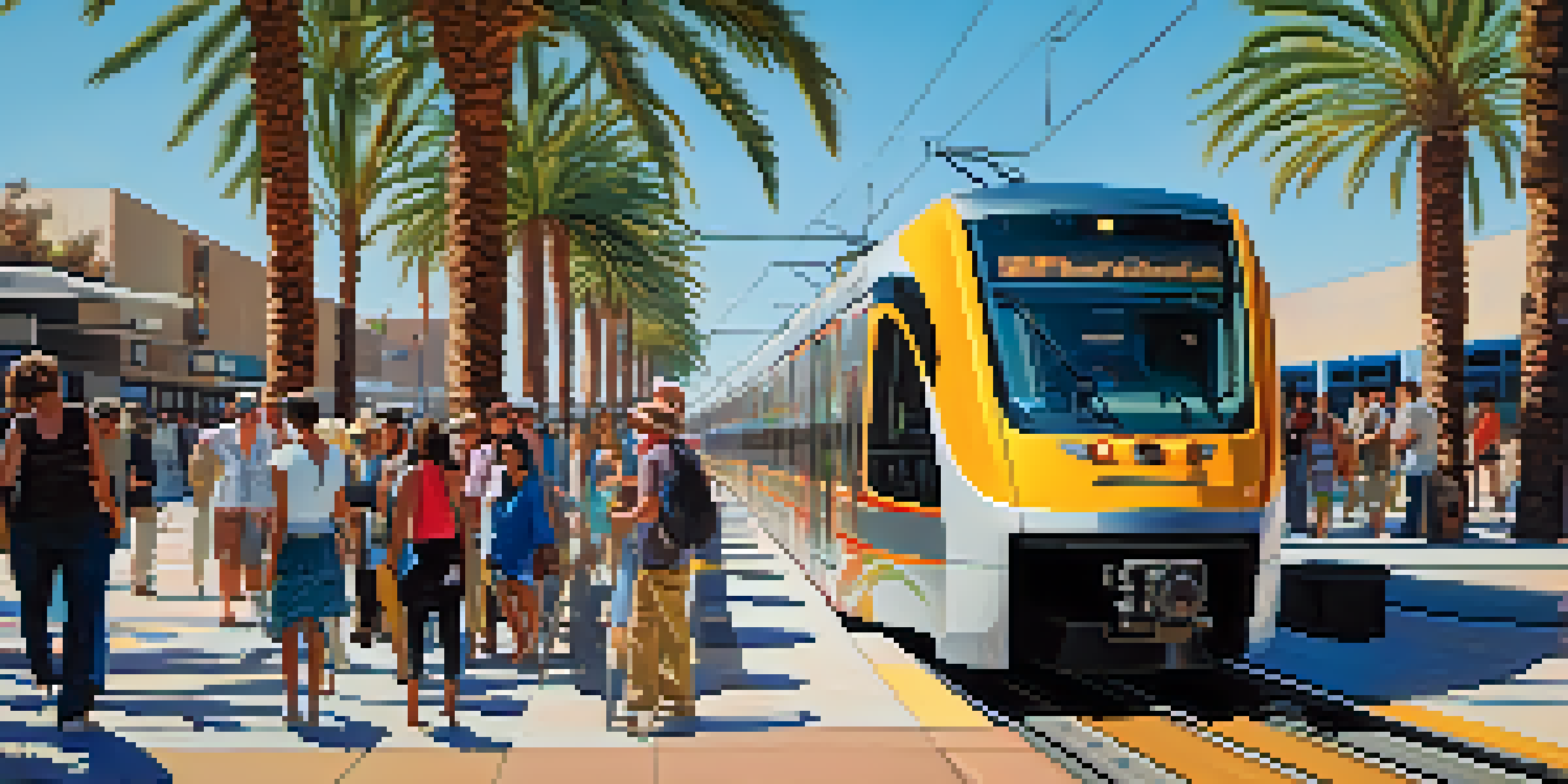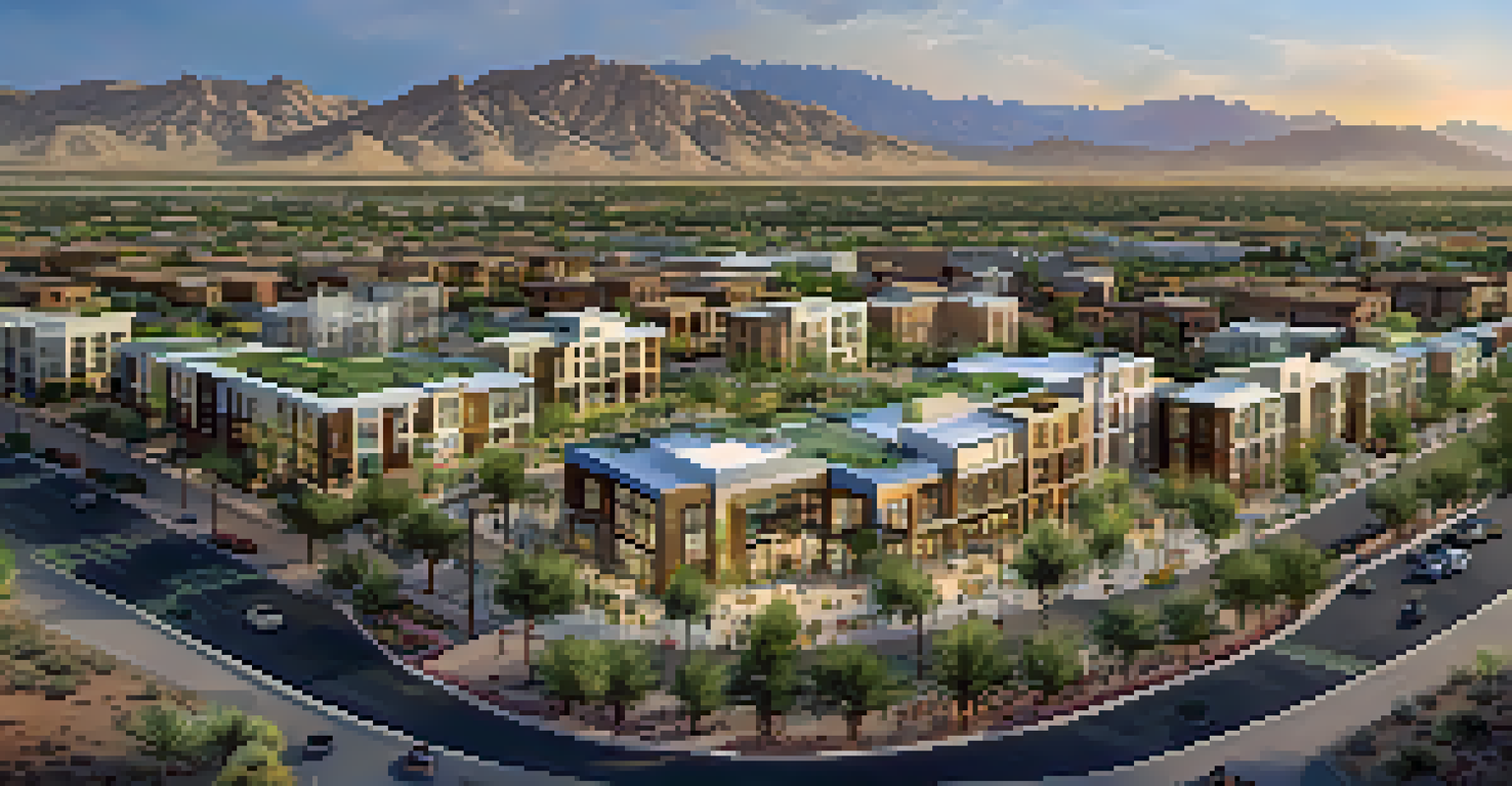The Rise of the Phoenix Metro Area: Public Transport's Role

Understanding the Phoenix Metro Area's Growth
The Phoenix Metro Area, known for its stunning desert landscapes and vibrant culture, has seen remarkable growth over the past few decades. As more people flock to this sunny locale, the demand for efficient transportation options has skyrocketed. This region's expansion is not just about housing and businesses; it’s also about how residents navigate their surroundings.
Public transportation is the backbone of a vibrant community.
With a population that has nearly doubled since the 1990s, the Phoenix area is a prime example of urban development in action. The rapid increase in residents brings both opportunities and challenges, particularly in terms of transportation. As traffic congestion becomes more prevalent, the need for reliable public transport solutions becomes critical.
This is where public transport plays a pivotal role. By providing accessible options for commuting, the Phoenix Metro Area can reduce traffic, improve air quality, and enhance the overall quality of life for its residents. The synergy between urban growth and public transport is essential for sustainable development.
Public Transport Innovations in Phoenix
In response to the growing demand for efficient transportation, the Phoenix Metro Area has embraced various public transport innovations. The Valley Metro system, which includes light rail and bus services, has expanded significantly, making it easier for residents to connect with essential services. This system not only serves commuters but also tourists eager to explore the area.

The light rail, for example, has transformed how people travel across the city, offering a swift and affordable alternative to driving. With convenient stops near major attractions, educational institutions, and employment hubs, it encourages the use of public transport over personal vehicles. This shift helps alleviate traffic congestion and promotes a more sustainable urban environment.
Phoenix Metro Area's Rapid Growth
The Phoenix Metro Area has nearly doubled its population since the 1990s, creating both opportunities and challenges in transportation.
Moreover, the introduction of smart technology in public transport systems has enhanced user experience. Real-time tracking apps and digital payment systems make it easier for riders to plan their journeys and navigate the system seamlessly. These innovations are crucial for attracting new riders and encouraging them to leave their cars at home.
Community Impact of Enhanced Public Transport
The improvements in public transport have had a profound impact on local communities throughout the Phoenix Metro Area. By making transportation more accessible, residents can easily reach jobs, schools, and healthcare facilities, which fosters economic growth and social mobility. This accessibility is especially beneficial for low-income families who rely on public transport as their primary means of travel.
The future of transportation is in public transit, and it has to be a part of the solution to our growing urban challenges.
Additionally, increased public transport options can lead to stronger community bonds. When people can easily connect with others in their neighborhood or city, it promotes interaction and collaboration. Events, markets, and community gatherings become more accessible, enriching the cultural fabric of the Phoenix Metro Area.
Furthermore, enhanced public transport can contribute to greater environmental sustainability. Fewer cars on the road mean reduced greenhouse gas emissions, which is essential for combating climate change. As residents embrace public transport, they are not only improving their own lives but also contributing to a healthier planet.
Challenges Facing Public Transport Development
Despite the progress, the Phoenix Metro Area faces several challenges in public transport development. Funding is often a major obstacle, as maintaining and expanding services requires substantial financial resources. Balancing the budget while meeting the needs of a growing population can be a daunting task for local governments.
Another challenge is public perception. While many residents appreciate public transport, others may still view it as a less desirable option compared to driving. Overcoming this stigma requires ongoing efforts to promote the benefits of public transport, such as cost savings, convenience, and environmental impact.
Public Transport Innovations Enhance Access
Innovations like the Valley Metro light rail and smart technology have improved accessibility and encouraged public transport use in the region.
Finally, infrastructure limitations can hinder the potential of public transport systems. Aging roads, lack of dedicated bus lanes, and insufficient connectivity between routes can create inefficiencies. Addressing these issues will be crucial for the future success of public transport in the Phoenix Metro Area.
The Role of Policy in Shaping Public Transport
Effective policy is fundamental to the success of public transport initiatives in the Phoenix Metro Area. Local government decisions regarding zoning, funding, and urban planning directly influence the development and efficiency of transport systems. By prioritizing public transport in policy discussions, leaders can create a framework that supports sustainable growth.
For instance, policies that encourage mixed-use developments near public transport hubs can enhance ridership. When housing, retail, and workplaces are closely integrated with transport options, it becomes more attractive for residents to use public transport. This holistic approach to urban planning can significantly reduce reliance on cars.
Moreover, advocacy for public transport must also be part of the political agenda. Engaging with the community to understand their transportation needs and preferences can guide policymakers in creating effective solutions. By listening to residents, policymakers can develop strategies that resonate with the community and foster widespread support for public transport initiatives.
Future Prospects for Public Transport in Phoenix
Looking ahead, the future of public transport in the Phoenix Metro Area appears promising, with numerous projects and innovations on the horizon. As technology continues to advance, the integration of electric buses and autonomous vehicles could revolutionize the way people travel. These developments not only improve efficiency but also align with the region’s sustainability goals.
Furthermore, expanding the light rail system and enhancing bus routes will likely remain a priority. As more residents opt for public transport, continuous improvements will be necessary to meet growing demand. Future infrastructure investments will also play a critical role in ensuring that public transport remains a viable option for everyone.
Community and Environmental Benefits
Enhanced public transport fosters economic growth, strengthens community ties, and contributes to environmental sustainability by reducing car reliance.
Ultimately, the success of public transport in Phoenix will hinge on collaboration among government, community, and businesses. By working together, stakeholders can create a comprehensive transport network that meets the diverse needs of the population while contributing to a vibrant, sustainable urban future.
Conclusion: The Future is Bright for Public Transport
In conclusion, the rise of the Phoenix Metro Area is closely intertwined with the development of its public transport system. As the city continues to grow, the importance of efficient, accessible, and sustainable transport options cannot be overstated. Public transport not only enhances mobility but also supports economic growth and environmental sustainability.
While challenges persist, the ongoing commitment to improving public transport infrastructure and services offers hope for a brighter future. By embracing innovation and prioritizing community needs, the Phoenix Metro Area can foster a transport network that serves as a model for other urban regions.

As residents increasingly choose public transport, they will contribute to a thriving, interconnected community. The future of the Phoenix Metro Area is indeed bright, with public transport poised to play a central role in shaping its development.